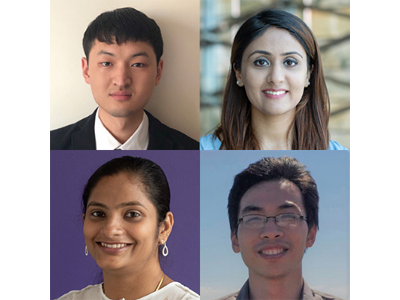The Marconi Society has named four 2018 Paul Baran Young Scholars, honoring them for their outstanding research and academic performance. The four will receive their awards at the Society’s annual awards ceremony in Bologna, Italy on October 2, 2018.
Dr. Di Che, a Member of Technical Staff at Nokia Bell Labs, is selected for his work on short-reach optical links for applications like data center inter-connectivity and optical access networks. His work is critical for companies like Google and Facebook, who build data centers around the world to support huge data transfers. These networks use large numbers of optical transceivers and Che’s proposed digital subsystems can be applied to upgrade existing systems in a cost-effective manner that increases speed while reducing power consumption.
Che’s advisor from the University of Melbourne, Professor William Shieh, says, “Di has conducted breakthrough work on coherent optical short-reach communications that significantly and cost-effectively increases the capacity-distance product. Some of this original work on novel digital optical subsystems has created new research directions which are being investigated in recent top-tier conferences like the Optical Fiber Communication Conference (OFC) and the European Conference on Optical Communication (ECOC).”
Qurrat-Ul-Ain Nadeem, a PhD candidate at King Abdullah University of Science and Technology (KAUST), is recognized for her work in full-dimension (FD) massive MIMO technology. FD-MIMO has attracted significant attention from the wireless industry as a promising technology for 5G cellular systems. Her research bridged the gap between the 3GPP’s vision for FD-MIMO and the theoretical study of elevation beamforming by proposing efficient active antenna array designs, developing 3D channel models and characterizing spatial correlation functions to support and evaluate this technology. The proposed elevation beamforming schemes can significantly increase the number of served mobile broadband subscribers in 3D urban macro/micro scenarios while guaranteeing a significantly improved quality of service.
“Qurrat’s work establishes a proper link between the industry’s vision for FD-MIMO and the theoretical study of 3D beamforming,” says KAUST Professor Mohamed-Slim Alouini, Nadeem’s advisor. “She published pioneering works on the development of 3D channel models and spatial correlation functions. More recently, she put different aspects of FD-MIMO together to provide a mathematical framework for the design of elevation beamforming schemes in single-cell and multi-cell scenarios. Her works have gained a lot of visibility in a short time.”
Rajalakshmi Nandakumar is PhD candidate at the University of Washington conducting ground-breaking work that enables the detection of potentially life-threatening health issues using commonly available smartphones. Taking inspiration from the sonar-based navigation system that bats use, Nandakumar created technology that turns an ordinary smartphone into an active sonar system capable of detecting physiological activities, such as movement and respiration, without requiring physical contact with the device. Her technology has been licensed by a leading provider to help patients detect sleep apnea from the comfort of their own bedrooms, rather than in expensive and uncomfortable sleep lab settings. Nandakumar’s technology is also being tested to detect opioid overdoses.
“Rajalakshmi has a knack for selecting problems with high social impact,” says Dr. Shyam Gollakota, an associate professor at the University of Washington’s Paul G. Allen School of Computer Science & Engineering and Nandakumar’s advisor. “What’s incredible is that she has developed technology that seems like science fiction and has gotten it adopted by hundreds of thousands of people in the real world. It is rare for a graduate student to have such impact with even one application, and she is doing it time and again.”
Dr. Ding Nie, an RF Engineer at Apple, is recognized for his work in developing models and systems to greatly increase throughput in wireless systems. Over the past decades, technical advances and consumer demand started the shift to devices with multiple antennas. While multiple antennas should theoretically increase throughput, they often suffer from issues associated with coupling, or the transmission of power between the antennas. Nie developed new throughput bounds for today’s multi-antenna systems by understanding the effects of coupling, guiding the design of antennas and circuits that will lead to increased throughput and faster wireless communications for consumers worldwide.
“Ding is the kind of person that you can let loose on a problem with little guidance and he comes up with very original ideas for solutions. He made a big advance in solving an open problem by coming up with new results that let us apply Bode-Fano bounds to multi-antenna systems,” says Dr. Bertrand Hochwald, Nie’s PhD advisor at the University of Notre Dame. “Ding’s work is so important that it attracted funding and leaves a legacy in my lab for another group of researchers.”
Young Scholar candidates are nominated by their academic advisors. Winners are selected by an international panel comprised of engineers from leading universities and companies and receive a $5000 prize plus expenses to attend the annual awards event. This year’s Young Scholars will be honored at the annual Marconi Awards Dinner where Akamai Co-founder, Dr. F. Thomson Leighton, a pioneer in the content delivery network services industry, will receive the $100,000 Marconi Prize.

